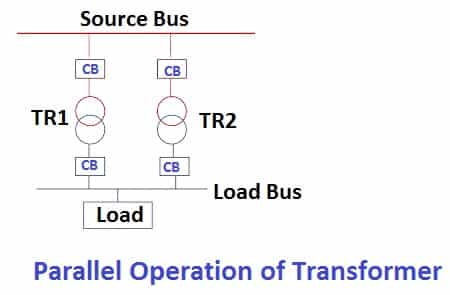Parallel operations of transformer: Definition-Connection of the primary winding of two transformers to a common supply voltage and connection of the secondary winding of both the transformers to a common load is the configuration of parallel operation of transformers. In parallel operation, the two transformers share loading.
Why Parallel Operation of Transformers?

It is more economical to install a number of smaller-rated transformers in parallel than a bigger-rated electrical power transformer. When we have two sources to run in synchronization, the parallel operation of the transformer is a must.
Advantages of Parallel Operation of Transformers
The parallel operation has mainly the following advantages.
1. Maximize electrical power system efficiency
The transformer operates at almost its full efficiency when it operates at full load. If we run a number of transformers in parallel, we can switch on only those transformers that will give the total demand by running nearer to its full load rating for that time. When the load increases, we can switch on one other transformer connected in parallel to fulfill the total power demand. This way, we can run the system with maximum efficiency.
2. Maximize electrical power system Stability
It is possible to take a transformer for maintenance if all the transformers run in parallel, thus the other parallel transformers in the system will deliver the load without total interruption of power.
3. Maximize electrical power system Flexibility
The total connected load can be increased or decreased according to the dynamic load scenario. If the load increases in the future, one more transformer can be installed, and it can be run in parallel with the existing transformers to cater to the total load requirement.
Conditions for Parallel Operation of Transformers
The following conditions must be satisfied for satisfactory performance when two or more transformers run parallel.
- The same voltage ratio of the transformers
- Identical percentage impedance
- Same polarity
- Identical phase sequence
Same Voltage Ratio
Suppose two transformers of different voltage ratios are fed the same primary supply voltage. In that case, there will be a difference in the secondary voltage if these transformers are connected to the same bus for delivering power to the common load. Then, there will be a circulating current between the secondary winding of both transformers, and it will lead to a circulating current between the primary winding.
The small voltage difference can cause a large circulating current to flow in the winding. Thus, circulating current causes I2R losses in the winding and causes heating of the winding. Therefore, the secondary voltage of both transformers must be the same for parallel operation.
Same Percentage Impedance
Both transformers operating in parallel must have the same percentage impedance. The current shared by the parallel transformer should be proportional to the transformers’ MVA ratings.
This is possible if both transformers have the same percentage impedance. The current delivered by these transformers is inversely proportional to their internal impedance. The internal impedance of the transformer is inversely proportional to its MVA rating. In other words, percentage impedance or per unit values of impedance should be identical for all the transformers operating in parallel.
Same Polarity
The instantaneous direction of the induced emf in secondary or primary is the polarity of the transformer. If the instantaneous direction of the induced secondary emf in two transformers is opposite to each other, a large circulating current flows from the secondary of one transformer to the other. In this condition, we can not run the transformers in parallel.
We can find the polarity of the transformer by the vector group of the transformer. The transformers with the same vector group are the necessary condition for parallel operation.
Same Phase Sequence
The phase sequence is the order in which the phases attain their maximum value. For parallel operation, the phase sequence must be identical. Otherwise, during the cycle, each pair of phases will short-circuit.
The above-said conditions must strictly meet for parallel operation of transformers but totally identical percentage impedance of two different transformers is difficult to achieve practically, that is why the transformers run in parallel may not have exactly the same percentage impedance but the values would be as nearer as possible.
Thanks,,i’m so proud to be the part of learner,, you give me a lot of knowldge !!!
Happy new year